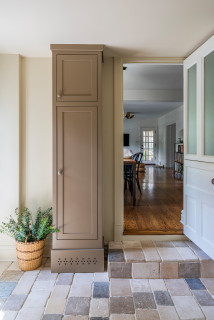
2. Add Decorative Wood Paneling and Trim
Crown molding, picture rails, wainscoting, hand-hewn banisters and balusters and other decorative trim brought dimension and artisanal flair to older homes. Beyond their beauty, these details often served practical purposes, including concealing imperfect seams and protecting plaster walls from scuffs and dents. While modern materials and construction methods make those functions less necessary, trim and paneling still provide a sense of craftsmanship and permanence that can instantly add character to a new build.
Your home’s architecture offers cues for the decorative trim that will suit it best. Victorians and Colonial Revival moldings tended to be taller and more ornate, for example, whereas Craftsman homes often kept trims simpler and chunkier, with visible joinery. These broader architectural styles can be broken down even further into subsets with their own signature details, so it’s important to be on the same page with your designer or architect about which style you’re after and carry it through the house for consistency.
This article was originally published by a www.houzz.com . Read the Original article here. .

Crown molding, picture rails, wainscoting, hand-hewn banisters and balusters and other decorative trim brought dimension and artisanal flair to older homes. Beyond their beauty, these details often served practical purposes, including concealing imperfect seams and protecting plaster walls from scuffs and dents. While modern materials and construction methods make those functions less necessary, trim and paneling still provide a sense of craftsmanship and permanence that can instantly add character to a new build.
Your home’s architecture offers cues for the decorative trim that will suit it best. Victorians and Colonial Revival moldings tended to be taller and more ornate, for example, whereas Craftsman homes often kept trims simpler and chunkier, with visible joinery. These broader architectural styles can be broken down even further into subsets with their own signature details, so it’s important to be on the same page with your designer or architect about which style you’re after and carry it through the house for consistency.